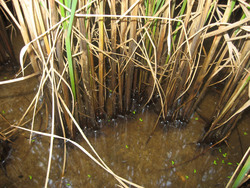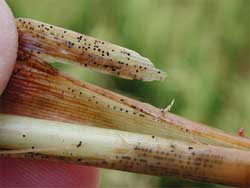Fayetteville, Arkansas?
June 5, 2009
 |
| Rice
stalks show signs of stem rot in a test plot. |
| |
 |
|
Nathan Slaton, associate professor of soil fertility,
describes soil fertility research for rice during a
field day July 24 at the Rohwer Research Station.
Insufficient potassium or excess nitrogen can increase
susceptibility of rice to stem rot. |
| |
 |
| The
survival structure of the stem rot fungus resembles
grains of pepper that float up in flood water and drift
around until they come in contact with rice sheaths.
They then attach and begin to move through the sheath
toward the hollow stem, where they can kill the stalk. |
Potassium may not be the first
nutrient growers think about when fertilizer is on their minds,
but research by University of
Arkansas System Division of Agriculture scientists shows
that early application in soil low in potassium improves rice
yield and suppresses stem rot.
"When plants are potassium deficient, they are more susceptible
to disease," said Nathan Slaton, director of soil testing for
the Division of Agriculture. "When disease is present and the
environment is favorable for the disease, it's more likely a
crop will suffer significant losses if there is insufficient
potassium."
Silt and sandy loam soils are often potassium deficient, Slaton
said. "Our soil test data show 30 percent of rice acreage in
Arkansas is low in potassium and another 30 percent has marginal
potassium levels," he said.
Slaton said it has long been known that there is an association
between potassium and stem rot. "Quite often, when you see very
severe stem rot," he said, "it raises a red flag to check
potassium levels."
Rick Cartwright, extension plant pathologist, said a fungus that
is highly adapted to the rice plant causes stem rot. It persists
in the soil and its survival structures look like grains of
pepper.
"It's very survival-oriented," Cartwright said. "It can survive
at least six years in the soil without a host."
Cartwright said that when a rice field is flooded, the fungus
floats to the surface and, when it comes into contact with the
plant, it attaches to the sheath and begins to work its way into
the stem. Once it reaches the hollow center, the stem dies.
"It's often a late-season disease that hits just about the time
the heads emerge," Cartwright said.
Slaton said that too much nitrogen could make a plant
susceptible to stem rot even if it has sufficient potassium.
"There are two questions you want to ask up front, if you're
having trouble with stem rot," he said. "Is there sufficient
potassium? And, is there too much nitrogen?"
Since 2000, Slaton has been applying varying rates of potassium
in rice test plots at the Pine Tree Experiment Station near Colt
for a fertility study. Cartwright began collecting samples of
mature plants from those plots and evaluating them for stem rot.
After six years in the study Slaton said the lowest levels of
stem rot were found in the plots with the highest application
rates of potassium and the highest rates of stem rot were in the
plots with the lowest rates of potassium. The results clearly
indicate that stem rot can build up over time.
"This tells us that long-term mismanagement of potassium can end
up costing growers in terms of losses to stem rot," Slaton said.
Graduate student Elliot Maschmann expanded the study in 2007,
adding test plots on farms in Lonoke and Poinsett counties, and
more sites in 2008 in Poinsett and Prairie counties. In addition
to application rates, Maschmann looked at application timing.
"In 2007, we saw that potassium applied before flooding worked
best," Maschmann said. "And as application rate increased,
yields improved. As rates decreased, stem rot increased in
severity."
Slaton and Cartwright also wanted to know if late applications
of potassium could reverse high levels of stem rot during a
growing season.
Slaton said mid-season application of potassium reduced stem rot
and gave a good yield response. Applications at late boot stage
also offered a 5 percent to 6 percent bump in yield.
"It will be an economic decision on whether a late potassium
application or a fungicide application will give a grower the
best bang for his buck," Slaton said.
Cartwright said the fungicide Quadris has some effect on stem
rot and may help control the disease until soil fertility is
balanced. Fungicide studies are still underway and it appears
that the economic return from a fungicide alone can be
questionable with this disease under some circumstances.
"Farmers who follow Division of Agriculture recommendations for
potassium and nitrogen don't have too much trouble with stem
rot," Cartwright said. |
|